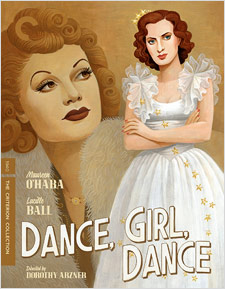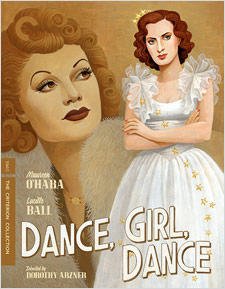Dance, Girl, Dance (Blu-ray Review)

Director
Dorothy ArznerRelease Date(s)
1940 (May 19, 2020)Studio(s)
RKO Radio Pictures (Criterion – Spine #1028)- Film/Program Grade: B-
- Video Grade: B
- Audio Grade: B+
- Extras Grade: B+
Review
If ever there was a scene stealer, it’s Lucille Ball in Dance, Girl, Dance. She’s not the star, but she’s the one you remember in a performance 12 years before she introduced the TV character Lucy Ricardo that would give her the super stardom Hollywood never did.
Dance, Girl, Dance focuses on two dancers from a troupe of young women making ends meet as showgirls in nightclubs. Judy (Maureen O’Hara) is a serious ballet student who aspires to bring her art to the public. Bubbles (Ball) is a brassy dame who uses her sensuality to get ahead. She knows exactly what the male audience wants to see and she delivers.
The nightclub where they are performing is raided to break up illegal gambling in the back room and the girls haven’t been paid. Wealthy playboy Jimmy Harris (Louis Hayward) takes up a collection among the patrons to pay the dancers. Judy is impressed with his unsolicited kindness and gallantry, and they become friends.
Bubbles, with her eye more on Jimmy’s money than his personality, succeeds in luring him away from Judy and then steals a job from her as a bump-and-grind dancer/stripper in a burlesque show. Later, she has Judy hired as a kind of stooge warm-up to her flashy act. The nearly all-male audience responds to the fully-clothed ballet interlude as expected, with catcalls, booing, and demands for Bubbles to return.
Meanwhile, Judy’s ballet teacher Madame Lydia Basilova (Maria Ouspenskaya) arranges for Judy to meet with an influential ballet impresario (Ralph Bellamy) at his studio. From the reception room, Judy can see the dress rehearsal for an elaborate ballet. This subplot becomes a parallel backstage story of personal lives intertwined with the trials of show business.
The film is helmed by the only female director working in Hollywood at the time, Dorothy Arzner. She takes time showing the ballet, which incorporates Ziegfeld pizzazz and Busby Berkeley patterns into traditional ballet movement and an en pointe solo.
Dance, Girl, Dance is rather stodgy. O’Hara plays a redheaded Irish immigrant with a fiery temper (we’re told). That supposed temper emerges only once, although there were many opportunities. Throughout the film, Judy is idealistic, rolls with the tough punches, perseveres, and takes abuse. She is strangely naive about burlesque and seems to have no idea that her toe dance is not the preferred fare of ogling male eyes. O’Hara, who is so dazzling in her Technicolor films, doesn’t convey the same vivaciousness in black and white, and her mousy portrayal leaves plenty of room for Ball to dominate.
With her wisecracks, sidelong glances, wriggling hips, and thrust bosom, Ball’s Bubbles is as much of a sexual woman as Hollywood would allow in the Production Code era. Never purely villainous, Bubbles is witty, ambitious, and very much aware of how to use her physical attributes to get ahead in a tough business. She has two burlesque solos, Oh, Mother, What Do I Do Now?, in which huge offstage fans blow off assorted articles of her clothing, and the jazzy Jitterbug Bite, in which she shimmies and shakes in a white fur coat. For a supporting role, Bubbles is a big showcase for Ball’s talents.
Hayward is so bland as a leading man that it’s hard to accept his Jimmy as the romantic focus of both Judy and Bubbles. He’s elegant and good-looking, yes, but never really lights up the screen. How wonderful if Cary Grant could have been cast. The role could have been expanded to take advantage of his charming screen persona and his casting would have breathed badly needed life into the film.
Director Arzner tries to show Judy’s passion for ballet, yet we never see her in extended dance numbers. When she does dance, the camera tends to film her from the waist up or in close-up. An obvious dance stand-in (we see her from the back) appears early in the film performing some difficult moves.
Dance, Girl, Dance attempts to be many things—a show biz tale, a glimpse into the world of professional ballet, the competition between a reserved artist and a flashy, sexy showgirl, and a romantic comedy. It’s unlikely that Judy and Bubbles would ever cross paths professionally, but the script’s conceit is that they are under the wing of Madame Basilova, who tries to get them any kind of work in tough times. In Madame’s words, “You don’t learn oomph. You’re born with it.” And if it weren’t for Lucille Ball, there wouldn’t be much to recommend. The film is worth a look just to enjoy her free-spirited, uninhibited performance.
The Blu-ray release from the Criterion Collection, featuring 1080p resolution, is presented in the aspect ratio of 1.37:1 from a newly restored 4K transfer. There are no scratches, dirt specks, or other imperfections, but the picture quality is not as sharp as one would hope. The overall appearance is flat, as foregrounds and backgrounds blend together. Blacks, which should be deep and rich, have a washed-out appearance. A double-decker bus and New York City street scenes are filmed with actors in the studio shot against back projections. There is an obvious contrast between the sharper studio footage and the slightly out-of-focus backgrounds. Maureen O’Hara is photographed in a non-glamorous manner. Her lighting tends to blend her into the scene rather than make her stand out. Lucille Ball, on the other hand, gets better lighting, especially when she performs her two musical numbers in bright, glistening outfits. Late in the film, as Judy sits at a nightclub table, she is backlit, providing her with the most flattering close-up in the film. The lighting contrasts reserved Judy and brash Bubbles and helps underscore their personalities.
The original monaural soundtrack was remastered from the 35-millimeter fine-grain optical soundtrack. The dialogue is precise throughout and the ballet rehearsal features jazz-influenced music. Ambient sounds, such as a foghorn, traffic noise, a boisterous audience, and rain hitting an umbrella on a New York street, are nicely blended with dialogue and give this studio-filmed movie a sense of being shot on location. Lucille Ball’s numbers are performed with full orchestra and are intercut with the hooting and cheering of the all-male audience. The song Morning Star is performed by a male nightclub singer as the camera dollies and settles on Judy and Jimmy. As they talk, the song is heard under the dialogue. O’Hara speaks softly, even when she faces an audience of ogling, rude men. Bubbles, armed with wisecracks, retorts, and quips, is loud and unafraid to speak her mind.
Bonus materials include a critical introduction, an interview with filmmaker Francis Ford Coppola, and a booklet containing a critical essay.
Introduction – Critic B. Ruby Rich provides an overview of the career of director Dorothy Arzner. When the Directors Guild was founded, she was the sole woman in it and the only female making feature films in Hollywood. Her career began in the silent film industry and extended to the end of World War II. Her tenacity, competence, and self-confidence saw her rise from title writer, script supervisor, screenwriter, editor, assistant director, and director. She developed the boom mic—a microphone mounted on a long arm that hung above the actors—to allow for greater camera mobility. Her first film was Fashions for Women (1927). Gender politics can be seen in her films. In Dance, Girl, Dance, Bubbles jumps from man to man, using them to advance her career. Arzner feels empathy for her female characters, so Bubbles is not a pure villain. Arzner adapts structures and expectations of the genre so women aren’t fatally injured. Arzner’s Craig’s Wife, in which a woman’s marriage affords her independence, is discussed. Arzner was known as a great director of actors and actresses and also a “star spotter.” She worked with Clara Bow, Katharine Hepburn, Joan Crawford, Rosalind Russell, Merle Oberon, and Lucille Ball. The director usually dressed in men’s style suits. She lived openly with a female partner, Marion Morgan, for 30 years. Marion was a choreographer and the two worked on four films together. Arzner’s last film was Last Comes Courage (1943). Because she had independent wealth, she left Hollywood at the end of World War II. In later years, she taught at UCLA. In the early 1970s, Arzner and her films were featured in several film festivals and were “re-discovered.”
Francis Ford Coppola: Remembering Miss Arzner – Director Francis Ford Coppola, originally a theater student in New York, became immersed in film study when he went to UCLA, one of only three or four film schools that existed at the time. “My professors were Hollywood greats,” including Dorothy Arzner, one of the few women to have achieved success in the new industry of film production. Her films were sophisticated, dramatic, and funny. “She was a salty kind of character… a mannish looking woman” with enormous heart. She dispensed knowledge she had accrued as director. As Coppola’s directing teacher, she advised her students to sit in the same spot next to the camera for the best perspective on the action and so that the actors could see you. The director is there to coach and support actors to do wonderful work. Arzner gave Coppola an inside view of cinema. “Miss Arzner was one of a kind.”
Booklet – The fold-out insert booklet contains a critical essay by Sheila O’Malley, a list of cast and key crew, information about the film’s digital transfer, and an artist’s color interpretation of Maureen O’Hara’s and Lucille Ball’s characters.
– Dennis Seuling

